Charging by induction
Charging by induction occurs when we bring a charged object near a conductor. It is not for no reasons that we say near.
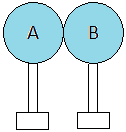
The charged object does not actually touch the conductor. The charged object is just allowed to get close to the conductor.
As a result, the conductor will be charged. We say that a charge has been induced in the conductor. We will make this clear with an experiment.
Experiment
Consider the two spheres above made with a metal. Since metal is a good conductor, it is a good choice for this experiment.
- They touch each other, so they become a single conductor.
- We put them on insulated stands so charges or electricity does not travel to the ground.
- The two spheres right now form a neutral system. This means that there is the same amount of electrons and protons in each sphere.
We get a rod that is negatively charged and we put it next to the two
spheres. The rod is shown on the right in green. The lines inside the
rod represent negative charges.
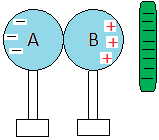
Electrons in sphere B are repelled by the rod and move to sphere A to create an excessive charge called also net charge. This situation creates also a net charge in sphere B.
We say that a charge has been induced on the spheres.
We can separate the spheres while the rod is still there.
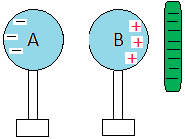
Finally, we can remove the rod completely.
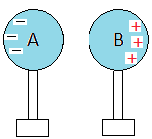
The spheres will keep their charges and this is what we mean by charging by induction. The charges on the spheres are equal and opposite.
The charges are equal because for each single electron that goes to A and therefore creates a single negative net charge, it leaves B with a single positive charge.
In our example above, 3 electrons went to A creating a situation where B has a positive charge with 3 protons.
Keep in mind that spheres A and B could have billions and billions of electrons. The reason that sphere A is charged now is because it has an excess of 3 electrons although this is a small charge. By the same token, the reason sphere B is charged is because it has 3 more protons now than electrons.
Charging by induction and grounding
Use only 1 sphere this time and induce a charge again with a charged rod. Then, put your finger where the electrons are.
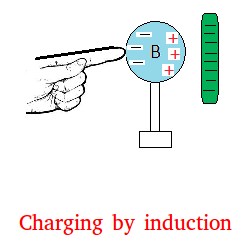
When you touch the metal with your finger, electrons leave the sphere by means of your finger and enter the ground.
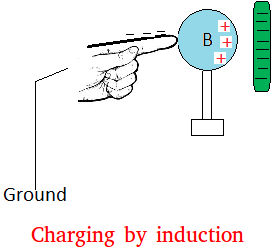
When we allow charges or electricity to leave a conductor by touching it, we are grounding the conductor.
Charging by induction quiz
A charging by induction quiz to see if you really know how to charge an
object by induction. You will not need to use a paper and pencil to
complete this quiz.
Objective of the quiz:
- Know what a charged object is.
- Know what a net charge is.
- Know what it means to induce a charge
- Know how to ground an object
- Know how to induce a charge.
- Know what it means to ground an object
|
Test your knowledge with the quiz below: |